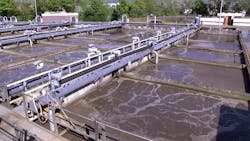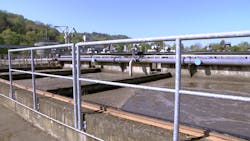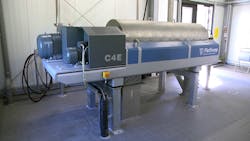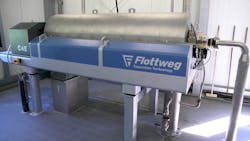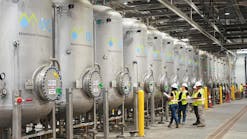German municipal plant improves efficiency with centrifuge system
The Trier Municipal Utilities main sewage treatment plant, located in the oldest city in Germany, is a purely municipal sewage treatment plant with anaerobic sludge stabilization. The plant is designed for a population of 170,000. The utility also manages a second plant, serving about 17,000 residents and about 100 buildings in the municipal region with 500 km (310 miles) of sewer.
To treat sewage sludge, the plant uses a decanter centrifuge to thicken excess sludge, which allows the plant to extend the time spent in the digesters. This means less water is pumped into the digesters, requiring less heat. The more extended the retention time, the greater the degree of stability and significantly greater gas yield.
“We didn’t want to use polymer,” Patrick Peukert, wastewater supervisor of the Trier Municipal Utilities main sewage treatment plant said. “We wanted a machine that could be operated around the clock with a high level of automation. The operational effort had to be very low due to our energy policies. We also wanted to find out our best option from an energy standpoint. So, it was clear to us relatively quickly that we had to go with just one centrifuge.”
VIDEO: Germany’s oldest city employs Flottweg separation technologyTo identify the best system for their needs, the management of the sewage treatment plant drew up a matrix of the factors they considered essential. The main focus was to run the machine without the use of polymer. It was also critical that it could be operated around the clock with a high level of automation. After comparing multiple systems, the decision was made to go with separation technology from Flottweg. Trier chose a Flottweg OSE Decanter, characterized by its high performance, reliability and efficiency.
The throughput is between 7 and 12 m3 per hour. “We don’t use any polymer at all,” Peukert said. “The machine runs 365 days a year, 24 hours a day. It is completely automated based on a temperature measurement in the feed. We also programmed the machine to automatically flush for 10 to 20 minutes at fixed times every day, and this can be freely selected.”
In 2012, the Trier plant did a complete energy assessment of the plant and reviewed procedures. Then in 2013, they started on the offensive. “We went at it with technical means and of course also changes to our process technology to reduce our energy consumption from about 4 million kWh to 3 million kWh,” Peukert said. “We also managed to raise our in-house generation rate to 3.4 million kWh. So, we actually have more energy at all times than the system needs for its own process. We pump power onto the grid.”
The excess sludge from the secondary clarifier is pumped into the OSE decanter. This separates the solid from the liquid by means of centrifugal acceleration. The excess sludge is thickened from 0.5–1.0 percent (5–10 grams per liter) dry matter (DM) to 6–8 percent DM. The dry matter content in the thickened sewage sludge depends on the pumpability of the thick sludge and the thickening equipment used.
Flottweg OSE decanters keep the discharge of dry material constant, thereby feeding the digestion tower steadily and maximizing gas yield. The continuous and automatic control to a predetermined dry matter content (e.g., 6 percent) leads to efficient and stable digestion.
The Simp Drive® concept generates a differential speed between the centrifuge bowl and scroll. This is decisive for the time the sludge remains in the bowl. With Flottweg OSE decanters, the differential speed is automatically adjusted depending on the current load in the machine. This means that the thick sludge concentration remains constant even with changing feed conditions.
A special scroll design with deep pond and steep cone increases the sedimentation volume in the decanter bowl. This enables a higher output density (10–20 percent) and makes the system more efficient.
Thickening centrifuges are operated at a very low primary speed, which keeps the electrical power requirement low. In addition, the Flottweg Recuvane® system reduces energy consumption by a further 20 percent. The OSE decanter has a very low flocculant requirement of only 1–2 g/kg dry matter.
Even polymer-free operation is possible. Lower quantities of flocculant and less energy are required, which leads to significant cost savings compared to other thickening equipment such as belt thickeners. Thanks to the compact design of the OSE decanter, there is a considerable reduction in floor space requirements. This makes replacement investments possible without any additional construction work.
“We were very satisfied with our collaboration with Flottweg,” Peukert said. “We had run some trials in advance, and we got very good results with the service staff on-site and very good communication. During implementation, Flottweg was always ready to answer all our questions. At the end of the project, as we were working on fine-tuning the system, Flottweg was always ready to support us.” WW
